Layers of The Sun Facts for Kids in 2024 (Fun & Interesting)
The Sun is the closest star to our planet. It is extremely important for all life on Earth. The Sun helps plants grow, which gives us food! It also provides energy to animals, tells us when to sleep and wake up, and even changes seasons!
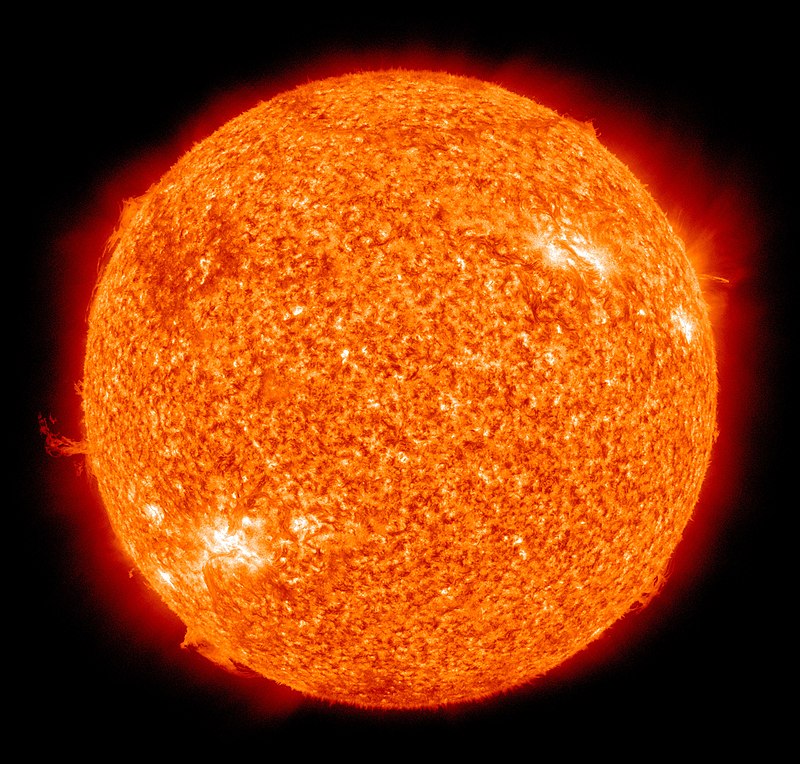
Did you also know that the Sun has different layers? If we could actually peel the Sun like an onion, we would see 7 separate layers. How cool! But what do all these layers do? Let’s find out!
Structure of the Sun
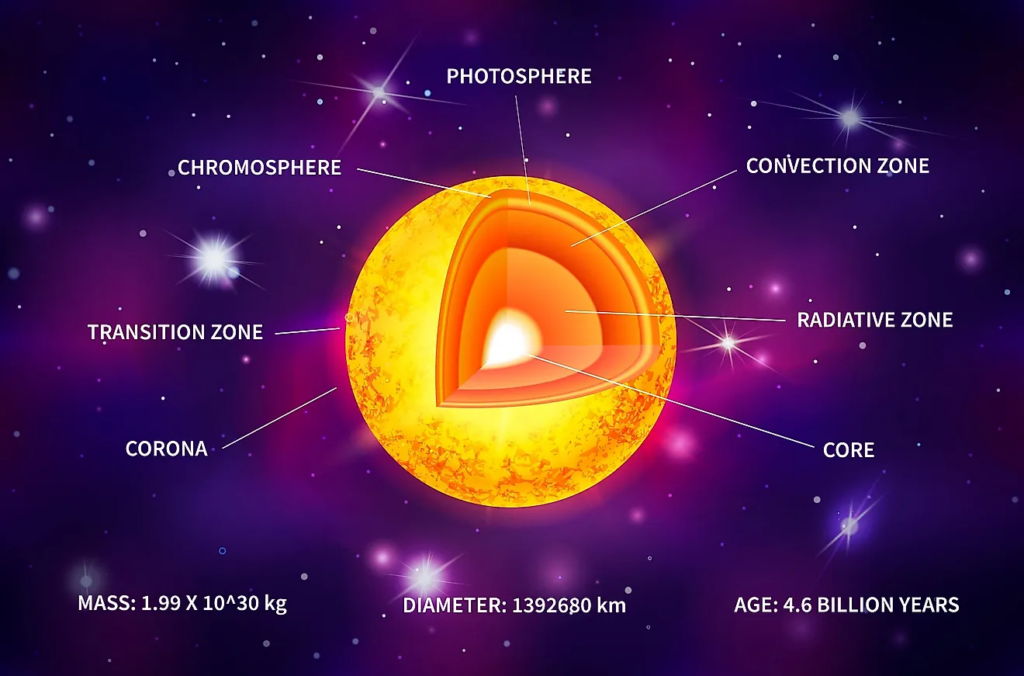
The Sun does not have a solid surface like the Earth. Neither does it have a solid core inside. The Sun’s 7 layers are divided into outer and inner layers. Let’s have a look at all the different layers of the Sun in order.
There are 4 outer layers and 3 inner layers. The inner layers are where the Sun’s energy is created. The outer layers act as a jacket of gases around the Sun, called its atmosphere. All these layers play an important part in helping the Sun release so much light and energy! Here is a list of the layers of the Sun in order:
Inner Layers
Core
The Core is the innermost region of the Sun. It is extremely dense! This means inside the Core, all the material is very closely packed in very little space. Like if you tried to cram a lot of clothes inside a suitcase!
But the Core isn’t solid at all! It’s actually made up of plasma. Plasma is a state of matter, just like solid, liquid, or gas. This plasma is very, very hot! The Sun’s Core has a temperature of 27 million degrees Fahrenheit – that’s 27 followed by six zeroes!
The Core contains about a quarter of the entire Sun. Inside the Core, nuclear reactions take place constantly. These reactions release a lot of energy. This energy then travels outwards through the Sun and finally becomes the sunlight and heat we get on Earth.
Radiative Zone
The layer just above the Core is called the Radiative Zone. The Core and the Radiative Zone together make up 70% of the Sun! The Radiative Zone is also very hot, with temperatures reaching up to 13 million degrees Fahrenheit.
It’s called so because the energy created in the core travels through this region in the form of light. Another word for light is radiation! This light is made up of extremely tiny particles called photons.
When the photons move through the Radiative Zone, they hit other particles on their way out! This makes them change direction and bounce around. The photons travel in this zig-zag manner and can take a very long time to make it out.
A single photon can take up to 50 million years to travel through the Radiative Zone. That means the light reaching you right now, was created inside the Sun millions of years ago! Imagine that!
Convective Zone
The Convective Zone is the last of the inner layers. It is a thick layer, about 125000 miles deep! It extends to the visible surface of the Sun. The temperatures in the Convective Zone fall to about 4 million degrees Fahrenheit.
The Convective Zone isn’t as hot as the layers below. This makes it hard for light to get through. The light turns into heat instead, which gets trapped inside the zone. This heat boils the plasma in the Convective Zone, like a pot of boiling tea!
The hot plasma from the bottom of the zone bubbles up to the surface of the Sun. Here it loses its heat to the space around it. As the plasma cools down, it starts sinking again. This entire process is called convection – hence the name!
Outer Layers
Photosphere
The Photosphere is the innermost outer layer. It is one of the coolest layers. The temperature here is only 11000 degrees Fahrenheit. But don’t be fooled, this is still hot enough to completely vaporize you in an instant! A lot of important events happen here, like sunspots and solar flares, which we’ll learn about later.
This layer is 60 miles deep. The Photosphere is also less dense than the inner layers, and so photons can escape easily from it! These are the same photons that ultimately reach us on Earth. Thus, the Photosphere gives rise to the Sun’s glow.
In photographs, the Photosphere looks like it is covered by grains of rice. This is due to granules. Granules are like packets of boiling plasma, and can be up to 700 miles long – about the width of Texas! A granule only lasts about 20 minutes, giving the Sun’s surface a constantly boiling pattern.
Chromosphere
The next layer is the Chromosphere. It is 2000 miles deep and glows red as it is heated by the Photosphere. This layer is less dense than the Photosphere and a little transparent, and so it is difficult to see from the Earth.
(Important Note: Never, ever look at the Sun directly! The Sun is very bright, and looking at it even for a millisecond can damage your eyes! Instead, get special glasses if you want to observe the Sun during special events, like solar eclipses.)
In the old days, the Chromosphere was only visible during solar eclipses. This is because the Moon would cover the Sun’s Photosphere, and a narrow red streak around the Moon could be seen. This is why Chromosphere means a ‘sphere of color.’
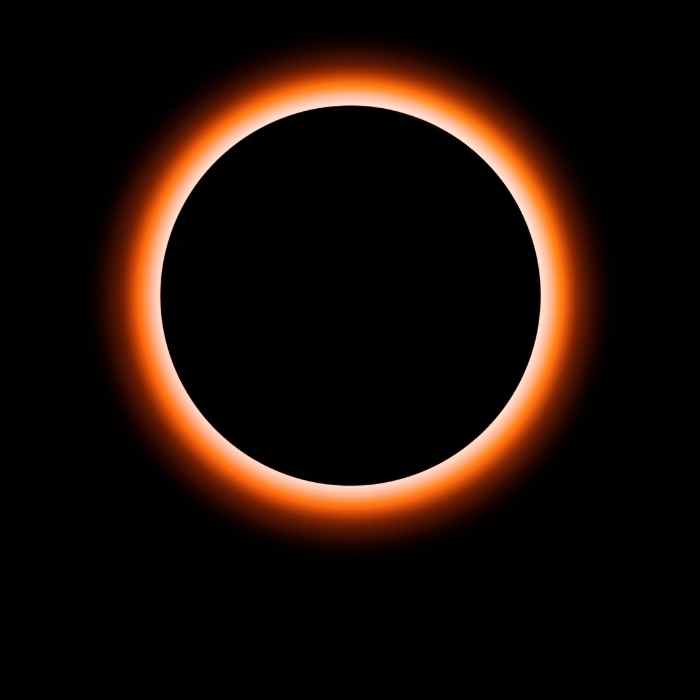
The temperature of the Chromosphere changes with distance. In the lower regions, it is about 10000 degrees Fahrenheit and falls to 6000 degrees as we move upwards. In the outer regions, however, temperatures can reach 36000 degrees Fahrenheit.
An interesting feature is called spicules. Spicules are long and thin fingers of glowing gas. They look like blades of grass. They rise to the top of the Chromosphere and sink back down every 10 minutes.
Transition Region
The Transition Region lies below Corona, which is the last layer of the Sun. It is extremely narrow compared to the other layers, with a width of only 60 miles. Like the Chromosphere, here too the temperature keeps rising as we move outwards.
The Transition Region is called so because it marks several changes between the Chromosphere and the Corona. The most important one is temperature. In the Transition Region, temperatures can reach over 50000 degrees Fahrenheit, much hotter than the Chromosphere.
The Corona itself is even hotter, as we will see. This sharp temperature change is called the temperature catastrophe. Scientists still don’t fully know why the temperature increases this way!
Corona
The Corona is the outermost layer of the Sun, also known as the Sun’s crown. The temperatures here can be over 5 million degrees Fahrenheit, which is much hotter than the visible surface of the Sun. The Corona is also much less dense than the Photosphere and is extremely transparent.
The Corona is usually hidden by the bright light of the Sun’s surface. That makes it difficult to see without using special instruments like a coronagraph. However, the Corona can still be seen as a glowing white ring around the Sun during a total solar eclipse.
The Corona extends millions of miles into outer space and thins out as it moves outwards. It has no observable upper limit! It extends so far out from the Sun that, here on Earth, we are technically living inside the Sun’s atmosphere!
Features of the Sun
Sunspots
Sunspots are the most noticeable features on the Sun’s surface. These are cooler, darker areas on the Sun’s surface, and have a crimson orange color. Each sunspot has a dark inside called the umbra, and a lighter outer region called the penumbra.
But don’t be confused by ‘cool’ and ‘dark’! The temperature of the umbra is about 7000 degrees Fahrenheit, while it is 10000 degrees Fahrenheit for the penumbra. What’s more, they only look dark compared to the Sun’s bright surface. A single sunspot still shines brighter than the full Moon!
A single sunspot usually lasts only a few days or weeks before disappearing. But groups of sunspots can last up to several months! Sunspots also contract and expand as they move across the Sun’s surface. Their diameters can range anywhere from 10 miles to 100000 miles!
But what causes sunspots? See, due to the extremely hot plasma, the Sun acts like a giant magnet! We can imagine this as giant magnetic loops around the Sun. But sometimes, these giant loops can break through the Sun’s surface. When this happens, the smooth transfer of heat between the layers of the Sun gets disturbed.
This disturbance causes the temperatures to reduce in some regions, creating sunspots. This is also why sunspots usually occur in pairs – one where the magnetic loop comes out of the Sun’s surface, and another where the loop goes back in.
Solar Flares
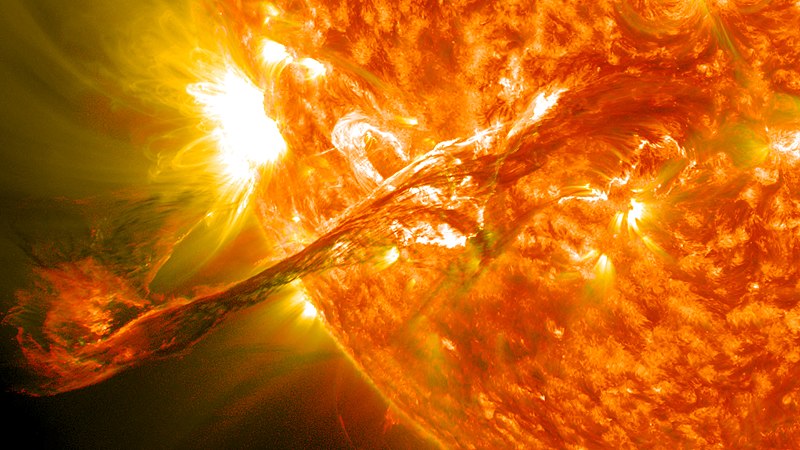
Sometimes, a loop of the Sun’s magnetism might snap and break! When this happens, it creates solar flares. A solar flare is like an explosion, releasing huge amounts of energy. Solar flares appear as sudden bright flashes across the Sun’s surface. They usually occur near a group of sunspots.
Solar Prominence
Sometimes, the plasma on the Sun’s surface starts flowing across these loops of magnetism, from sunspot to sunspot. This causes a glowing arch that can extend into the Sun’s corona, looping hundreds of thousands of miles into space! These loops are called Solar Prominences or filaments.
Prominences can form over a day and last for months. Sometimes, these prominences are so powerful that they break and burst outwards! This throws out matter from the Sun out into space, at speeds of about 500 miles per hour. These are called erupting prominences.
Coronal Mass Ejections (CMEs)
The gases in the Sun’s Corona are so hot and fast-moving that sometimes they escape the Sun’s gravity. This is called a Coronal Mass Ejection, or a CME. When this happens, a stream of particles is released, called the solar wind.
These particles flow outward into space at speeds reaching 1 million miles per hour! Scientists believe that the Sun loses 10 million tonnes of material through these winds every year. CMEs can also happen due to intense solar flares, or from erupting solar prominences.
CMEs have a very big impact on life on Earth. They can disturb Earth’s satellites in space, causing failures with Internet and weather services. They also carry large amounts of radiation, which are harmful to the human body.
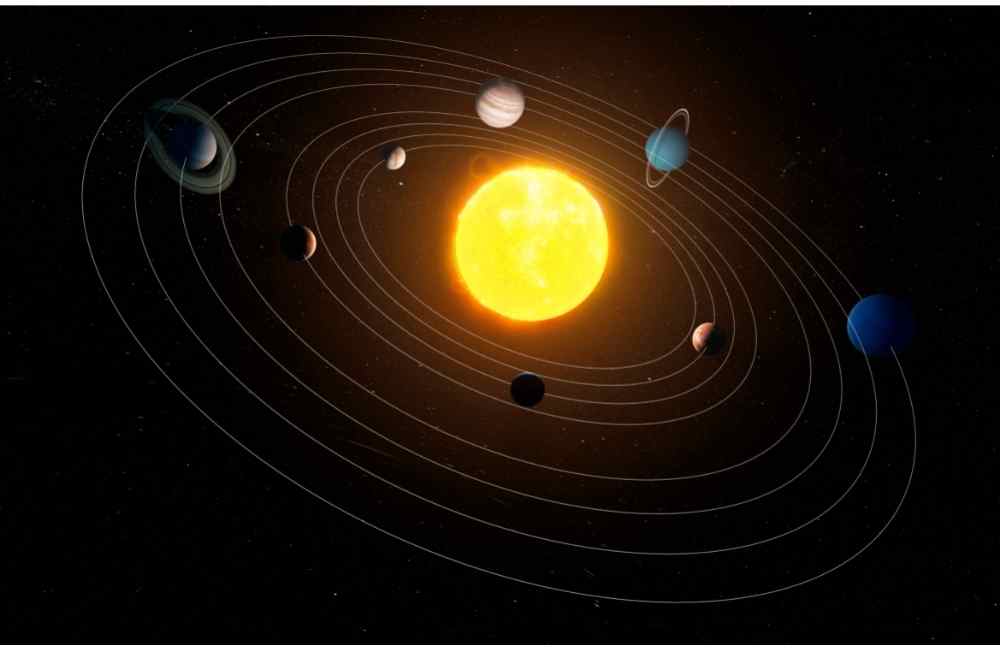
Just like the Sun, the Earth also acts like a giant magnet and has magnetic loops. But when large CMEs hit the Earth, they disturb these loops, causing them to break and reconnect. This releases large amounts of energy into the atmosphere. This is called a geomagnetic storm.
Geomagnetic storms can lead to power failures and cause electronic devices like phones and laptops to stop working. A geomagnetic storm in 1989 knocked out Quebec’s electricity grid for 9 hours! A similar storm in today’s times could cause damages worth trillions of dollars.
When slower solar winds reach Earth, the Earth’s magnetism protects against them. But at the poles, the magnetic loops go back into the Earth and thus can’t act as a shield. When solar winds strike the air above the poles, the atmosphere gets heated and starts glowing. These beautiful displays of lights are called auroras. The Northern and Southern lights are both auroras!
The Solar Cycle
Sunspots, solar flares, CMEs and other solar events together make up the Sun’s activity. After a lot of research, scientists have discovered that these events roughly follow an 11-year cycle, called the Solar Cycle.
The number of sunspots regularly rises from a minimum to a maximum and then back, over a solar cycle. Solar flares and CMEs also become active and then go quiet every 11 years. The reason behind solar cycles is still being studied. The current cycle, which began in December 2019, is called Solar Cycle 25.
How do we study the Sun?
As said earlier, staring at the Sun can damage our eyes. This makes looking at the Sun directly through telescopes a big no-no! Scientists instead use special filters in telescopes, which block out damaging parts of the Sun’s light. One such filter is a coronagraph, which blocks the Sun’s Photosphere, allowing scientists to study the Corona!

The Big Bear Observatory, one of the largest solar telescopes, can view features on the Sun as small as 50 miles across! Another method is to study the Sun’s light instead, to find the Sun’s temperature, density, brightness, mass, and other stuff! This is called spectroscopy. We have also launched special spaceships to study the Sun. For example, NASA’s Parker Solar Probe, launched in August 2021, is expected to reach the Sun’s atmosphere by 2025!
Interesting Facts and Amazing Numbers
The Sun is massive! It weighs 4 nonillion pounds – that’s 4 followed by thirty zeroes! It’s equal to around 330000 Earths. The Sun also makes up 99.9% of the entire mass in the solar system.
It is three-quarters hydrogen, and the rest is helium. Inside the Sun, nuclear reactions turn hydrogen into helium, releasing massive amounts of energy. Fun fact! Helium was first discovered in the Sun using spectroscopy, long before we knew it existed on Earth!

The Sun has a radius of 430000 miles and is about 93 million miles away from the Earth. This distance is called an astronomical unit. It takes sunlight 8 minutes to travel and reach Earth.
The Sun is a yellow dwarf star. It is 4.6 billion years old and will last for 5 billion years more before it runs out of hydrogen. By that point, it will have expanded to swallow Mercury, Venus, and Earth! Then, it will become a red giant star.
